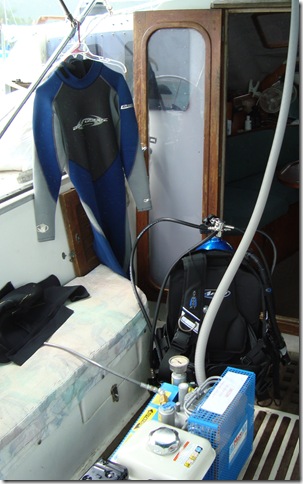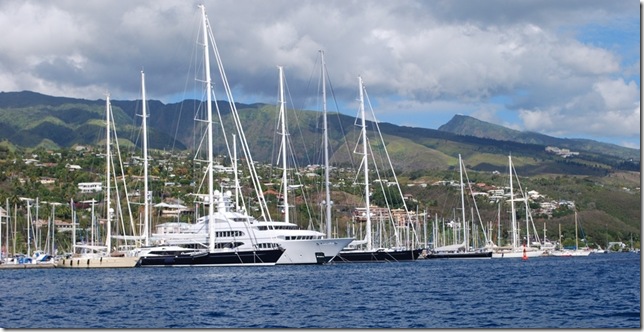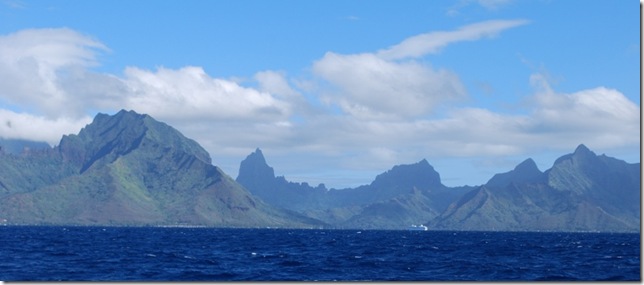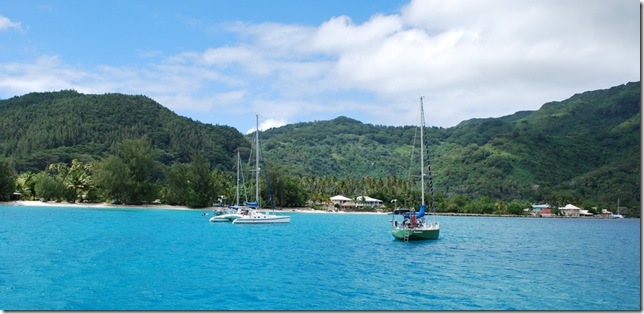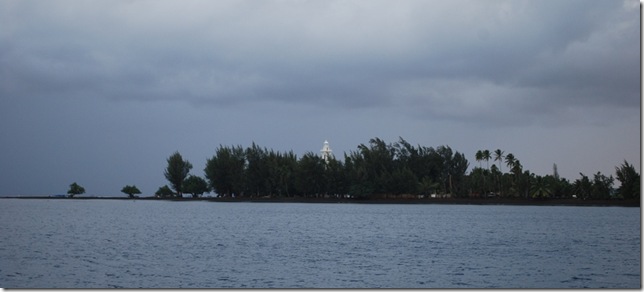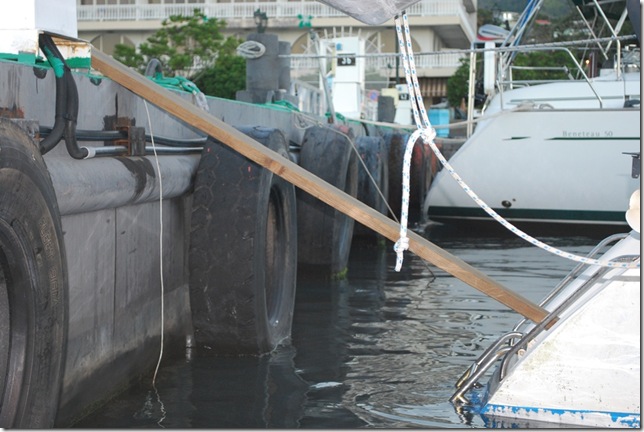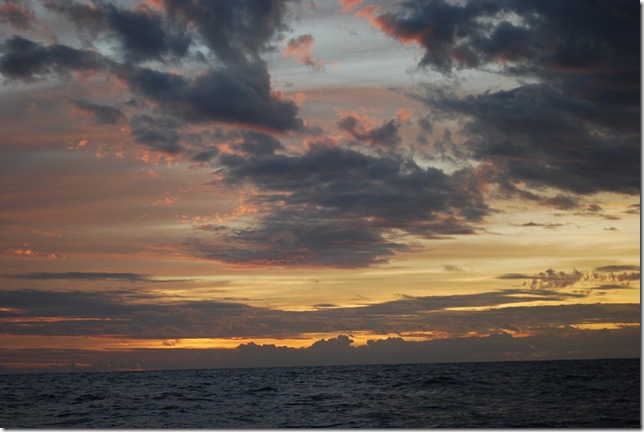Well, we finally broke out the air compressor and filled our own scuba tanks for the first time yesterday. It took about an hour (minus the pauses for rain) to fill two tanks for Dallas and myself (Wes and Tiff were exploring ashore), and once we figured out whose gear was (it has been a long time), we were all set. We considered yesterday’s dive to be a simple test run of our new equipment, as it was late afternoon after a day of rain, but the visibility underwater was much better than we expected. We set off from our boat and swam over to where we had been snorkeling in the morning, near the mouth of the pass. Swimming with around 50 pounds of gear on my back was rather challenging, but as soon as we dropped down below the surface, it was magical. There were multitudes of fish of all colors and patterns feeding off the diverse coral heads. Most of the fish inside the shallow (50′ or less) reef were fairly small, but they ranged in size from around an inch to two feet. Some of the most impressive ones in my mind were those that completely blended in with their environment. Darwin (though not a diver himself) would have been impressed. Specifically, there were some that were the same shade of white as the lagoon floor that I could hardly see until they moved. There were others that were speckled brown and beige just like the coral heads. I tried several times to point them out to Dallas, but each time the elusive little suckers slipped back into hiding. Another noteworthy variety was the boxy-shaped little fish with yellow polka dots overlayed onto its purple sides and white polka dots on its black topside. We also saw a large eel menacingly peering out of its chosen territory. We were underwater for a mere 36 minutes so as to avoid being around for feeding time, but I think that both Dallas and I could have stayed there for hours.
I would like to mention that Dallas was a very good dive-master, allowing me to explore at will while keeping me abreast of our course and timing using hand signals, which we are getting the hang of. He used a compass to track our position, and when we popped up, we were just about where he expected us to be, just a short distance from the boat. I was both impressed and relieved.
We decided to have another go at it this morning, this time using the dinghy to get out to the larger pass. Dallas maneuvered the dinghy around a landmine of coral heads in order to get close to our desired drop spot, we lodged the little mushroom anchor on the windward side of a large coral head, and set off to see what we were up against inside the pass. I have to admit that I was a little skeptical, as it was 10 minutes before high tide when currents could be strong–a risky situation when not accompanied by a dive-master who knows the site well. Dallas assured me that we would take it easy and return to shallow waters at the first sign of strong current, so off we went.
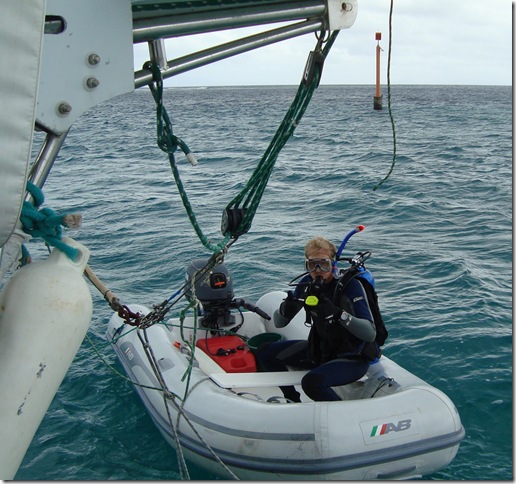 Dallas and dinghy are ready to go
Dallas and dinghy are ready to go
When we came to the edge of the pass, there was an immense wall of coral that was covered with fish of every color imaginable. I would say the most common colors were black and white, but I saw many shades in between such a deep violet, iridescent periwinkle, and others only found in the very large Crayola boxes. Beyond the wall, we could see nothing but ocean. Both Dallas and I later described it as the “abyss”, and I still can’t think of a better word. At this point, instead of hand signals, Dallas and I gave each other the nonverbal “Oh my gosh” which, with a mask on your face and regulator in your mouth, can only be communicated by making one’s eyes REALLY big. We swam along the wall for a bit and came up to the busiest underwater intersection I have ever seen. (Think of downtown Manhattan at lunch hour when the crosswalk signal turns green.) There were schools of fish swimming up and down the wall simultaneously, and yet, it wasn’t chaotic at all. Quite the opposite. Everything down below feels incredibly peaceful. Anyway, after swimming almost the length of the pass, Dallas motioned for us to turn around, and we headed back over the wall and through the shallows that were dotted with large, diverse coral heads. Not only was the coral the most diverse I’d ever seen, but the organisms feeding on it were quite unique. For example, there were a couple of little yellow growths that looked like plastic trees from a Lego set. Many of the colorful coral feeders snapped shut as we swam past, reminding us that they were in fact alive. When we finally emerged from the other world of the sea, Dallas’ first words were “still skeptical?” Needless to say, I was pretty pleased that we had taken the plunge (pun intended).
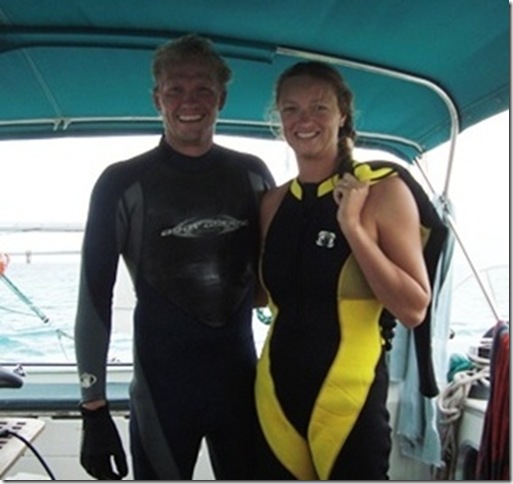 . Back from another great dive
. Back from another great dive
There are many other notable experiences from today (e.g., biking to the marae, finally finding some good pizza, hanging out with Germans on a monohull), but as it is almost 1 a.m., I think I’ll call it a night. The wind is currently gusting to 40 knots (thereabouts), so it could be a wild one!
I agree with Dallas that Papeete turned out to be not very charming, but it was a city nonetheless, and I was excited to see what it had to offer. In particular, I was hoping to find diverse and reasonably priced groceries, some interesting foods to eat that were prepared by someone other than me, cold coke and beer from the fountain and tap, respectively (for the first time since Panama), and some cultural exhibitions of some sort. I managed to experience most of these. The fountain drink was the first item to be checked off the list, and despite that it was 3x the price of a Coke from 7-11, it tasted just like it. Yum.
Next came the food. Wes, Tiff, and I went on a walking tour of the entire downtown area on Monday and picked up some fresh tuna at the large open-air market (just ignore the flies) that Tiff later seared to perfection. Later, in diligently doing our duty for all of you back home by exploring what the nightlife of Papeete has to offer (the short answer: nothing on a Monday night), Tiff and I not only got a cold draft beer from the local brewery but also found a caravan of trucks representing various restaurants set up near the cruise ship dock and treated ourselves to a delicious crepe with Nutella inside. For those of you who haven’t had the pleasure of sampling Nutella, it is a hazelnut-cocoa spread for pastries, bread, etc. that is popular in Europe and apparently, French Polynesia. I’m not sure why it never caught on in the U.S., but I guess it’s hard to compete with the flavor and protein of good ol’ PB&J. Sending kids to school with Nutella sandwiches for lunch would probably elicit envy from classmates and concern from lunchroom aides.
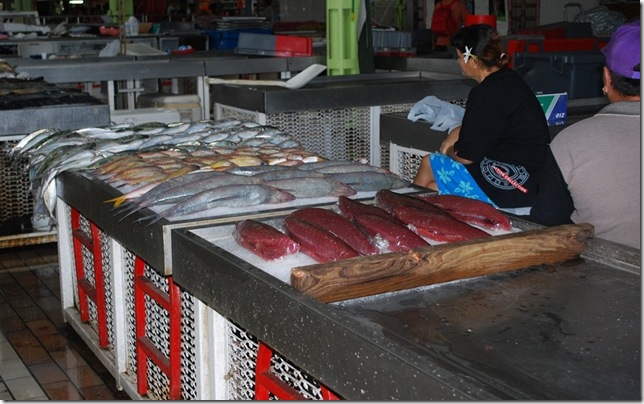 Very fresh fish from Papeete market
Very fresh fish from Papeete market
While I’m digressing on the subject of international food, Dallas has declared that "baguettes are dumb." He expounded, "They are a nice curiosity or international experience, but as far as day to day, they get hard too quickly. Technology has moved beyond that. We can make soft bread now." Just FYI.
In terms of cultural experiences (beyond the baguette), Papeete is not the place. I drug Dallas to the "Maison de la Culture" Tuesday morning only to discover that it is simply a large theater for evening performances. However, when I asked the ticket agent about exhibits, she directed us to a nearby art gallery that had some really beautiful oil paintings, many of which portrayed Polynesians in traditional Polynesian activities (dancing) or dress. One of my favorites was called "The Tuamotu" and showed an older, rotund man standing on the beach of an atoll wearing a simple straw hat, a shirt half-way buttoned, and cotton pants. His face was fairly expressionless, and he was surrounded by three mangy dogs. It really encapsulated what we observed in terms of the simple life on the atolls of the Tuamotus.
The highlight of Wednesday morning is that we were able to pick up our package that Tim and Heather (Dallas and Wes’ brother and sister-in-law) sent via Fed Ex containing our two new Acer laptops–one to replace Tiff’s old Acer that I fried by plugging in the wrong adapter (yes, I continue to make more than my share of mistakes out here), and the other to replace Dallas’ Dell that succombed to the marine environment. They are the perfect computers for the cruising life given their very long battery life (~7 hours!) and compact size. Also included in the package were American magazines (so Brittney’s making another come-back?) and delicious snacks and drink mixes that, if we could find them here, would cost 5x as much. The cost of sending this wonderful package was outrageous, though, so you’ll will have to hold off on sending us that care package you’ve been planning!
We finally got out of Papeete on Wednesday around noon after a few complications. The first was that when Dallas went to clear out with immigration and the port authority, he was told by the men at both windows that he needed to see them first. As Dallas stood there trying to figure out what to do (with a perplexed look on his face, I’m sure), the man at the immigration window threatened that he was leaving, and Dallas would have to return several hours later if he didn’t go there first. Despite the threat, the port captain must have looked more intimidating, as Dallas chose to see him first. Fortunately, it was a good choice, as the other man remained to help him before leaving.
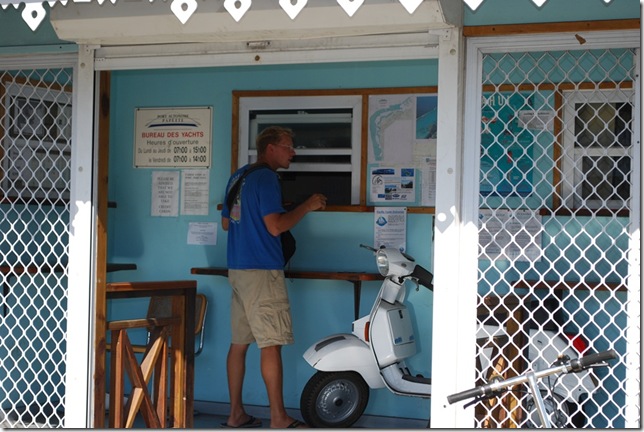 Dallas trying to figure out how to be two places at once
Dallas trying to figure out how to be two places at once
Another complication was that our anchor was stuck, tangled on a thick line. This was anticipated, so we had a very long dockline at the stern that was used to control the boat’s movement while dealing with the anchor so as to keep us from hitting other boats, slamming against the quay, or other such calamities. Dallas dove down to considerable depth to free the anchor and is still trying to get the hearing to come back and the ringing to stop in his left ear, but other than that, there was no harm done.
The final complication was having the oil pressure alarm sound yet again on the port engine. Dallas and Wes didn’t feel comfortable heading out on only the starboard engine with parts and supplies so close, so we ended up heading around the west side of Tahiti to Marina Taiina to spend a night at anchor and take care of the problem. Dallas fixed it relatively quickly with an adjustment to the pressure regulator valve that we purchased in Panama, and we headed ashore to grab a beer and take a gander at the gi-normous sailboats docked there. We thought about using the laundry facilities at the marina, but at $15 a load, we figured we’d just do it ourselves. It’s not like we don’t have the time!
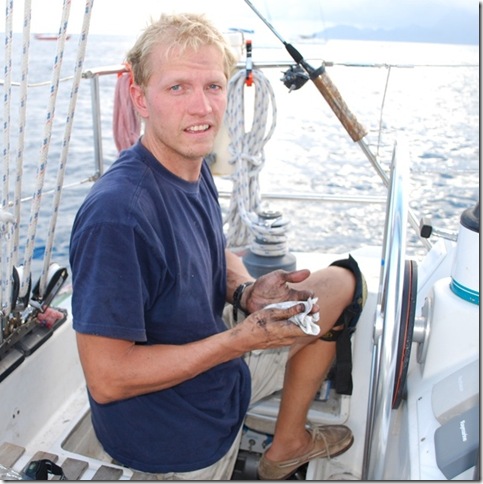 Finishing up in the engine room
Finishing up in the engine room
Yesterday (Thursday) we sailed over to Huahine. We decided to skip Moorea since we spent an extra night in Tahiti, but we had a beautiful sail past its north shore and snapped some photos, so that’s almost like having been there. The island appeared to have a considerable reef around it, but we hear that the snorkeling is better in Bora Bora. Anyway, en route to Huahine, I read some English news (yay!) from a New Zealand newspaper that we got in Papeete. For the most part, it was similar to current issues and events in an American newspaper (e.g., government spending, social issues such as gay couples’ adoption rights), but there were a couple of stories that I have to share. For one, there was a brief article reminding residents that the voting on "smacking" was ending tomorrow. Whether or not corporal punishment of one’s children should be a criminal offense is being put to a national vote with the "no’s" winning 80% or so. The other story was about a man from Tonga (where we will be going soon) who had moved to NZ and was not aware that it was not OK to cook his dog in the backyard so that he could have it for supper! His response to the media attention was simply, "In Tonga, it is OK to eat the dog. The dog is very good."
My night watch was challenging. We have gotten used to easy tradewind sailing ("set it and forget it"), but the inter-island runs require a little more effort and skill. The light wind shifted around to the south and was coming from our aft quarter, and we were sailing under the main and jib. In these circumstances, it is apparently very typical on boats like ours for the mainsail to block the wind from the jib, which then flaps around begging for attention. Indeed, it received a couple of hours of my attention until Dallas relieved me on watch and informed me that there is not much you can do in these circumstances to appease the jib. We can’t extend the main out all the way because we have cap shrouds on either side of the boat extending up to the top of the mast (I’ll post a picture to show what I mean.). Anyway, sailing continues to be intriguing as I stumble up the learning curve.
We are now in Huahine, one of the leeward islands of the Society Island group. (I’m going to let Dallas explain the meaning behind the island’s name in his next blog, as it was obviously named by a man.) The pass into the channel around the island was fairly easy to transit, but you should see the size of the waves breaking on the reef! There are some pretty fearless surfers out there as we speak. Perhaps we will meet them, as we are hoping to spend a few days here exploring, snorkeling or diving, and posting pictures using the wi-fi they have here. There is also a resort here for $700/night (!), but we’ll probably skip that, as we have our own comfortable accomodations aboard Pura Vida.
First we’ll answer some cultural questions of the greatest significance. Is there a McDonald’s in Papeete, Tahiti, French Polynesia? Yes. Does it serve a "Royale with cheese"? Yes. Are the french fries served with mayonnaise? Yes, the mayonnaise pump is next to the ketchup pump.
We made it to the island of Tahiti Sunday around midnight and instead of trying to negotiate the pass and enter the port and capital city of Papeete, we elected to anchor and get some sleep. We dropped anchor in Matavai Bay, southwest of Venus Point, with the Venus Point lighthouse sweeping its light above us. Venus Point is where Captain Cook came to observe the transit (solar eclipse) of Venus in 1769 for the Royal Society, which had sponsored his voyage (Cook recognized the Royal Society by naming this group the Society Islands).
The calm anchorage awoke slowly, but early. We could see and hear cars driving on the busy road by the beach. Several people on the beach were working with an outrigger 100 yards or so off the shore to catch fish in a large net, and a morning soccer game was going strong in the small field near the lighthouse. The healthy barking of the pet dogs here sounded noticeably different than the barks of the mongrel atoll dogs, and though there were are some roosters crowing, it was nothing like the morning din in a Marquesas village.
The mountain peaks were visible beneath the clouds on the way to the pass and we were able to see the diadem, a Tahiti mountain feature that resembles its namesake. Entry formalities weren’t bad, and we even got a form that will allow us to by diesel duty-free when we leave from Bora Bora. Yachts have traditionally moored "Tahitian-style" here in Papeete with their stern tied to bollards at the quay along Pomare Blvd (King Pomare was the first monarch to convert to Christianity) and an anchor set off of the bow. We had our chance to try this for the first time, and it’s definitely a challenge. We had a strong wind at our stern, which is not a bad place for the wind, but we only learned after tying up that there are now bow lines tied to moorings and we didn’t need to anchor. The only casualty was a helm/AIS VHF antenna that is mounted at deck level and was snapped off when it was caught in a dockline. Hopefully, our anchor won’t be tangled up in all of the stuff on the bottom here.
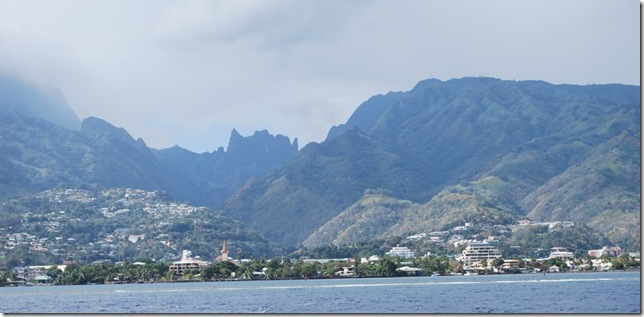 Diadem above the suburbs of Tahiti
Diadem above the suburbs of Tahiti
Although tying up along Pomare Blvd used to be a tradition, most yachts now go to the large Marina Taina, about 10 miles away on the northern edge of the west coast. We were headed there as it’s free to anchor out, but we’re waiting for a package from Fed Ex with replacement laptops to clear customs and are hoping that one more night here will allow us to leave a for Moorea a bit quicker. In case you’re wondering, there are two reasons we didn’t shop here for laptops. The first is that since we’re a yacht in transit and aren’t importing the good into Tahiti permanently, we’re able to avoid paying import and VAT/sales taxes. The second reason is that the computers here run the French version of Windows.
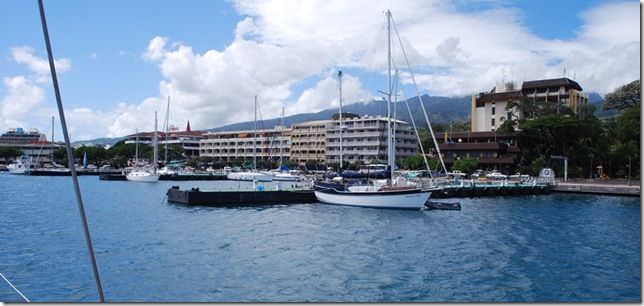 We tied up at the second dock, at the edge of Pomare Blvd.
We tied up at the second dock, at the edge of Pomare Blvd.
Papeete itself is a moderate-sized city. It’s not especially clean or beautiful, but there’s plenty of shopping. Prices in general are high, but you can get almost anything you want here. The grocery prices are definitely cheaper than in the more remote islands, but the restaurants are more expensive. The architecture is pretty plain and the people don’t seem as happy or relaxed. After time in such quiet, beautiful places my preference is definitely to leave the big city as soon as we can and head back to more scenic and less populated places.
Our Brazilian friends on Matajusi came over for a visit yesterday evening and Silvio had a good story from their Panama-Galapagos crossing. 300 miles offshore, he spotted a speedboat, which seemed like an odd thing. It made more sense when he noticed the next day that what he thought was a shark behind the boat was actually a fishing buoy, and there was quite a lot of very heavy offshore fishing line that had become caught on the boat’s underbody and was being towed behind him. He was getting ready to jump in and try to free it when he looked down and saw a massive shark swimming behind the boat! Apparently it had made its way along the long stretch of line, eating the fish that were hanging from the hooks embedded in it and was now at the end of the line, so to speak. Ultimately, the shark left and Silvio was able to jump in and clear the line.
In a twist of good luck, I was able to buy the same model of VHF antenna at a local marine store at a reasonable price. Carrying the 8-foot antenna tube while riding the folding bike back along the edge of Pomare Blvd. (Papeete’s non-bike-friendly main thoroughfare) and through round-abouts was a bit of an adventure. As I neared the dock, a French guy on a bicycle behind me pedaled past and had a few things to say about my riding with the antenna that I didn’t entirely comprehend. I’m sure he was complimenting my agility resourcefulness in avoiding a long walk or large cab fare.
Lat: 17 17.277′ S
Lon: 149 06.195′ W
Antoine had warned us that the "bombies" (Australian for coral heads) were bad where we had anchored in Fakarava and that we shouldn’t be surprised if we had trouble getting our anchor and chain up, as it may be wrapped around or stuck underneath a coral head. I’ve seen a windlass get pulled right out of a wooden deck by a captain who had his anchor chain wrapped around a coral head and tried to use the force of the swell to break it loose (thinking is was just stuck in the mud). When push comes to shove between a coral head the size of a van, ocean swell, and some part of a boat, the boat generally doesn’t fare well. Our chain was indeed stuck on a coral head, but the wind had only shifted slightly to the north while we had been anchored, so we let some more chain out, motored to the north to try to undo the effect of swinging south, and as they say here, "Voila!" In the process of anchoring I also discovered why our windlass has been so weak — the clutch needed to be tighter. There’s a manual clutch that you turn like a screw to engage or disengage the windlass motor from the gypsy (turning wheel the chain runs through). By using a wrench to tighten it instead of my hand, it was able to pull much harder without slipping, and I didn’t have to pull any of the chain or anchor up by hand at all!
Here I have to make a short digression to share a funny windlass story that Antoine told me. He had called us on the radio one night but couldn’t hear our response (cheap West Marine Radio), so I dinghied over to see what was up. He just wanted to know how our passage to Fakarava had been, but I stayed and chatted for a while. He mentioned that he was having trouble with his windlass and needed a part, but the windlass and spares were no longer in production. Since our boats were both designed and built in France within a year of each other by like-minded architects, I asked him was model of windlass he had. It turns out that it was the same windlass that was previously installed on our boat but was replaced by the previous owner (and probably just had a wiring problem). It was still in a locker when we bought it, so I’d sold it to a second-hand sailing store in St. Augustine, FL. I would be surprised if they’ve sold it, so maybe he’ll be able to contact them and buy the part he needs. (He’s been trying in vain to find the part in France.) If that wasn’t coincidence enough, he told me the story of replacing a certain part on the same windlass several years ago. After four or five years, the part had gone bad again, but now the windlass was out of production. He was trying to get by for a while and thinking about what to do when he was walking on an atoll in the Tuamotus and saw the very part he needed lying around! It was being used by a guy who sold diesel to prop up some piece of equipment. Antoine explained to the man that it was anything but scrap metal to him at the moment, and the guy told him to take it. After inspecting it more closely, he realized that it was the old part from his own windlass that he had left on the atoll years before when he got the replacement part. Although it wasn’t in perfect condition, it was now better than the "new" part, and he’s still using it in his windlass today.
Before leaving, I tried a new showering method. We’ve had several people tell us that you can enjoy a great "shower" by just jumping in the ocean naked, then toweling or rinsing off. As this seems to be the method practiced by the Swiss boat anchored in front of us, and the anchorage only had a few very salty residents, I gave it a shot. It’s definitely my favorite method so far. It’s very refreshing, and shampooing your hair with both hands while you’re treading water makes for pretty good exercise. The downside is that Irish Spring doesn’t really lather well in salt water.
We had great wind from the NE when we pulled the anchor up, so we were able to sail from the anchorage, through the pass, and then on a heading for Tahiti. Even though the north pass in Fakarava is the widest in the Tuamotus (1.5 km), the current was still strong enough that we almost had to turn on the engines to avoid being swept onto the west side of the pass. The tide was coming in, and our speed was slowed so much by the current that our leeway (wind in the sails pushing the boat sideways) and the swell was slowly pushing us from the east side of the pass to the west.
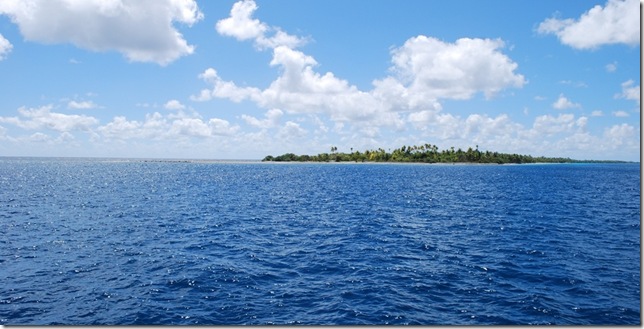 Sailing through widest pass in the Tuamotus
Sailing through widest pass in the Tuamotus
The passage itself has been pretty uneventful. We ended up motoring the first night because the winds were too light to keep the sails set. We’re almost 2 knots faster under power after cleaning the bottom and props, so that does make the hours of work seem more worthwhile. In the morning, we set the green spinnaker, and it’s been up ever since. We’ve had a lot of hours with an average speed between 2 and 3 knots, but the wind picked up this morning and we’re doing a very easy 6+ knots and are only 25 nm from Point Venus, where Captain Cook observed the transit of Venus, the official purpose of of one of his circumnavigations (simultaneous measurements of the eclipse were intended to allow a calculation of the circumference of the earth).
We have had some cool fauna sightings. Friday night, when I went out to make a 15-minute check, I saw a bunch of glowing blobs in the water and called Lauren out on deck. We were motoring through large schools of glowing jellyfish that were between volleyball and soccer ball size. We motored through several of the schools over the next 15 minutes, which was a really cool sight. The water is so clear out there that it’s hard to tell how far down they were, but they seemed to be within 1-6 feet of the surface.
As I was near the stern preparing to set the spinnaker just before dawn Saturday, I heard the unmistakable sound of breaching. I turned around and saw a large dolphin or small whale, about 12-15 feet long, break the surface to exhale a couple of times. It was only about 15-20 feet from the stern, but in the pre-dawn twilight, I couldn’t make out enough color or detail to tell what it was.
Yesterday morning, one of the large flocks of fishing birds came close to the boat. We see them fairly frequently, but this time, there were large fish, about 2 feet long, jumping out of the water below them. Apparently the large school of fish was being hunted from below and above at the same time.
Yesterday the temperature in the salon reached a record 89 degrees, which was a little warm, although when it got down to 80 degrees in the evening with a light breeze, I was cold enough that I had to put on a T-shirt. We were talking today about how the passage to New Zealand is going to be such a climate shock for us. I’m sure we’ll be searching for pants and sweaters when the temperature drops below 75.
Odds and Ends
Here’s a collection of miscellaneous observations about the Marquesas and Tuamotus that didn’t make it into previous blogs, but that we found interesting.
On every island and atoll there was a concrete recreation area with a basketball goal at each end. With possibly one exception, all of the basketball goals had the hoops (not just the nets) missing. I’m not sure what master plan saw the people of French Polynesia taking up basketball, but it never caught on. Volleyball is popular here (as it was in the Galapagos) and soccer is played on the concrete areas as well, but bocce ball seems to be the most common game, especially among the adults.
Finding a toilet (especially a public one) with both toilet paper and a toilet seat is a somewhat rare occurrence. Many cruisers carry toilet paper in a ziploc bag as a permanent part of their shore bag. Another interesting restroom feature that’s not uncommon is a lack of running water. In this case, there is usually a large barrel of water nearby and you simply carry small buckets of it to the toilet to fill the tank before or after you flush.
It’s not unusual for Polynesians to have visited the US. They hold French passports, and because of the nuclear testing that occurred in the Tuamotus, salaries were fairly high, and the French have consented to maintain a significant flow of cash into Polynesia now that the nuclear testing has stopped. Hawaii, Los Angeles, Las Vegas, and New York seem to be popular destinations.
We’ve already mentioned that pigs and chickens are often kept in the yard. Roosters are sometimes tied by the leg to a tree, pigs are usually tied by the leg, and many hens and roosters wander free. Of course if you have a pig in the yard, it’s so that someday it ends up on the table, and Lauren and I both heard the sound of a pig being killed for slaughter the day before the bishop came to Kauehi. I was walking back to the boat while she was walking to the store, but it was one of the first things we brought it up the next time we saw each other. It’s a sound you instantly recognize but never hear in the US no matter how many bacon cheeseburgers you eat.
When we were talking with Jimmy on Kauehi, he said “Obama, Yes We Can” several times. It’s really hard to appreciate the widespread influence of US pop culture and politics until you come to the middle of the ocean and find that people here really care about the US president and the death of Michael Jackson. It reminded us of visiting Bermuda in November last year, where hand-painted Obama signs were a common sight. We overheard a local telling a story about the scene in Bermuda on election night in the US. Apparently a couple of the bars in the main town were full of people watching the returns, and when the result was announced, people from a bar frequented primarily by white Europeans & Americans ran out into the street where they found the people from another bar down the street frequented primarily by black locals also rushing out. The two groups stopped and looked at each other then ran toward each other. When the groups met in the middle of the street, there were high fives and cheers all around. To me, the amazing thing is that no matter what your preference is in terms of the train of Republicans and Democrats that fill the oval office, someone on a small island in the middle of the ocean is more passionate about the US President than many US citizens are. It’s also an almost certain guarantee that a local will really like at least one well-known US singer (though their taste can be entertaining).
An interesting thing seems to happen when someone from a modern Western culture becomes an ex-pat and is deprived of the opportunity to speak with people that either speak English or share the same cultural background and general news interests. They become ravenous for conversation with English speakers with a similar perspective. There was an Australian guy on Ua Pou that was married to a local and was the only native English speaker we met in the Marquesas. He was in his 70’s and was almost impossible to end a conversation with unless you just walked out of sight. Lauren and I met someone similar in Jamaica, a Canadian who had retired in “paradise”, but even with English as a local language, he was starved for conversation with a North American. With my French being pretty rudimentary, I was surprised at how excited I got when we met a someone who spoke Spanish as well. Although it’s possible to get around and take care of necessities without a common background and very little common language, it’s really nice to talk to someone with whom these are shared.
The feet of people who go barefoot for a lifetime are very large, especially wide, and calloused. It’s hard to imagine them ever fitting into shoes. Some of the old men in the procession at Kauehi were barefoot or wearing only flip-flops. English speakers call this route through the Pacific “the (coconut) milk run” but the Germans call it “the barefoot route.” It’s easy to identify the ones that have actually lived the barefoot life.


